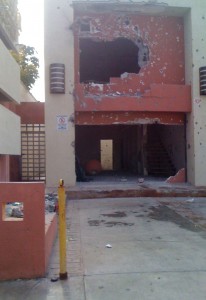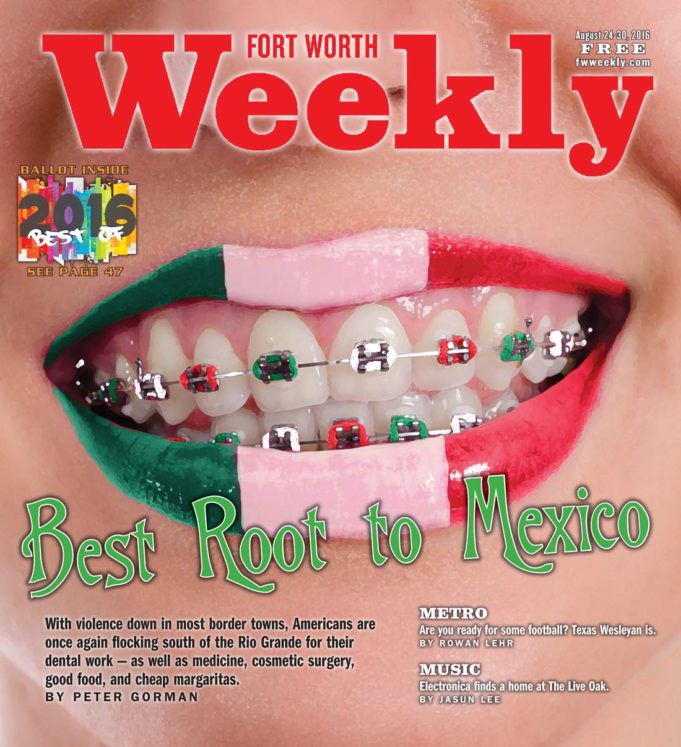I wasn’t quite sure what I’d run into when I recently took off from Joshua in a rental car with my former wife, Chepa, and her two young daughters on our way to get some dental work done in Mexico. We were headed to Nuevo Progreso, a small border town famous for its dental and medical work and not known as a particular hot bed of drug war violence, like the nearby cities on the border, Matamoros and Reynosa. Still, there were several violent incidents in the past couple of years — small stuff, relatively speaking — that raised a few hairs on the back of my neck. I was particularly concerned about the girls: 10-year-old Sierra and 8-year-old Alexa, because of the threat of kidnapping.
But Chepa, who had visited Nuevo Progreso last year with a couple of her sisters and a friend, was determined to go, calling my fears silly.
“You might have seen problems in Matamoros when you were there last, but you don’t know Nuevo Progreso,” she said. “We just park the car on the U.S. side, walk across the bridge, and there we are. If there are any problems, the border guys will let us know, and we won’t go over.”
Truth was, I needed some serious dental work. The repairs on my mouth from a bad accident decades ago were falling apart, and I was beginning to look like someone’s crazy uncle with missing lower front teeth. Chepa needed work as well, and Alexa needed a root canal in a baby tooth that wasn’t likely to fall out for another couple of years and which would have been bad to simply remove while her teeth were still coming in.
So a couple of Tuesdays ago, we set off at 8 a.m. in a brand new Kia Sorrento heading south on I-35. It was going to take eight hours or so to reach the border town of Brownsville, where we had planned to stay the night, so I let Chepa and the girls fall asleep during the first part of the drive.
I had no idea what the cost of the work we needed would be, but whatever it was would be considerably cheaper than it is in the States. We had already received a couple of quotes from local dentists on Alexa’s root canal ($1,400) and a crown ($1,800). My work was going to cost at least a few thousand. Chepa’s, too. Here we were looking at probably $10,000 altogether, while I was hoping it could all be done in Nuevo Progreso for less than two large. I wasn’t sure the work would be as good as it is here, but then Mexico’s border towns have been famous for quality dental and medical work for a long time. U.S. citizens, primarily from Southern states, have a long history of jumping across the Rio Grande to get their teeth work done cheaply and quickly. And while they’re there, a lot of them also enjoy great food and nightlife and the general party atmosphere for which the Mexican border towns are famous.
Or were until internecine fighting broke out among the drug cartels over the best routes on which to move the illegal products, which included drugs and people. The last time I was in Mexico, in late 2010, it was to cover the tension in the border towns for a story for this paper (“Dead Zone,” Jan. 5, 2011).
At that time, things were pretty bleak.

In 2010, I drove with a friend across bridges over the Rio Grande five times to Mexican border cities in two or three days. Each crossing took some resolve –– the drug war was raging. Part of it was attributable to the fighting among the cartels for the few lucrative points of entry to the United States. Another part, a big one, involved a corrupt national police force fighting some drug cartels on behalf of other drug cartels. And a huge part of it was the Mexican Army, whose members wore ski masks and who had a reputation of creating mayhem whenever they showed up during a gunfight, killing everyone in the area with reckless abandon.
At that time, pictures of headless bodies hung from highway overpasses were seen in newspapers regularly. Bags of human heads occasionally showed up in bars and nightclubs. Kidnapping young men and forcing them to work for the cartels was commonplace. Mass graves holding dozens of the dead seemed to be discovered weekly.
The drug wars were old by then. They really started back in 1993, when Amado Carillo Fuentes (“Lord of the Sky”), head of the Juarez Cartel, let the Colombians know that from that point on, Mexican cartels were not going to take a piece of the drug-money action for moving Colombian cocaine and heroin into the United States. Instead, the Mexican cartels said they would give Colombia a piece of the action, the action that the Mexicans declared now belonged to them. The Colombians didn’t like it, but the two cartels that could have stopped it, the Medellin and Cali cartels, had both been decimated over the previous few years — no new cartels with the power and reach of either had risen to take their place. That change in the way business was done had a near instant effect of making several cartel heads billionaires. Carillo, who died during plastic surgery in 1997, was estimated to be worth $25 billion at the time of his death.
But other cartels, including the Guadalajara, Tijuana, and Gulf cartels, also saw their funding and their resulting power rise, and things that had been popular among the Cali and Medellin leaders were suddenly available to the Mexican cartel leaders as well. Instead of having gangs of dozens and a few federales on the payroll, these upstart cartels suddenly had hundreds of well-armed soldiers and whole police forces available to them. Several owned private zoos stocked with exotic animals. Some had whole fleets of planes and dozens of hidden airstrips throughout Mexico. There was so much money for those at the top that rumors of cartel leaders who had whole rooms stacked floor-to-ceiling with packages of $100 U.S. bills went around the world.
Over the past 20 years, several of those rooms have been discovered.












